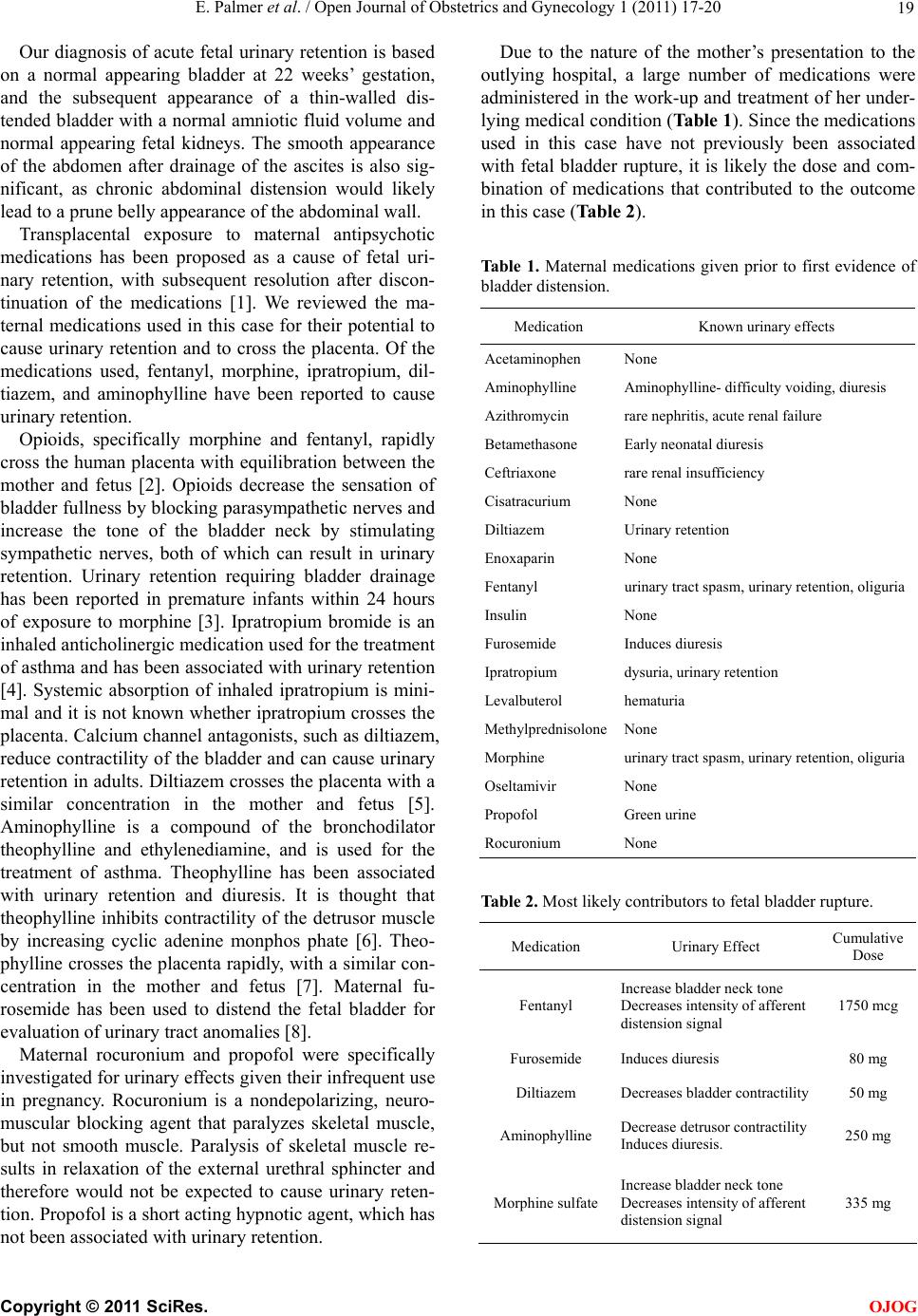
E. Palmer et al. / Open Journal of Obstetrics and Gynecology 1 (2011) 17-20 19
Our diagnosis of acute fetal urinary retention is based
on a normal appearing bladder at 22 weeks’ gestation,
and the subsequent appearance of a thin-walled dis-
tended bladder with a normal amniotic fluid volume and
normal appearing fetal kidneys. The smooth appearance
of the abdomen after drainage of the ascites is also sig-
nificant, as chronic abdominal distension would likely
lead to a prune belly app earance of the abdominal wall.
Transplacental exposure to maternal antipsychotic
medications has been proposed as a cause of fetal uri-
nary retention, with subsequent resolution after discon-
tinuation of the medications [1]. We reviewed the ma-
ternal medications used in this case for their potential to
cause urinary retention and to cross the placenta. Of the
medications used, fentanyl, morphine, ipratropium, dil-
tiazem, and aminophylline have been reported to cause
urinary retention.
Opioids, specifically morphine and fentanyl, rapidly
cross the human placenta with equilibration between the
mother and fetus [2]. Opioids decrease the sensation of
bladder fullness by blocking parasympathetic nerves and
increase the tone of the bladder neck by stimulating
sympathetic nerves, both of which can result in urinary
retention. Urinary retention requiring bladder drainage
has been reported in premature infants within 24 hours
of exposure to morphine [3]. Ipratropium bromide is an
inhaled anticho linergic medication us ed for th e treatment
of asthma and has been associated with urinary retention
[4]. Systemic absorption of inhaled ipratropium is mini-
mal and it is not known whether ipratropium crosses the
placenta. Calcium channel antagonists, such as diltiazem,
reduce contractility o f the bladder and can cause urin ary
retention in adults. Diltiazem crosses the placenta with a
similar concentration in the mother and fetus [5].
Aminophylline is a compound of the bronchodilator
theophylline and ethylenediamine, and is used for the
treatment of asthma. Theophylline has been associated
with urinary retention and diuresis. It is thought that
theophylline inhibits contractility of the detrusor muscle
by increasing cyclic adenine monphos phate [6]. Theo-
phylline crosses the placenta rapidly, with a similar con-
centration in the mother and fetus [7]. Maternal fu-
rosemide has been used to distend the fetal bladder for
evaluation of urinary tract anomalies [8].
Maternal rocuronium and propofol were specifically
investigated for urinary effects given their infrequent use
in pregnancy. Rocuronium is a nondepolarizing, neuro-
muscular blocking agent that paralyzes skeletal muscle,
but not smooth muscle. Paralysis of skeletal muscle re-
sults in relaxation of the external urethral sphincter and
therefore would not be expected to cause urinary reten-
tion. Propofol is a short acting h ypnotic ag ent, which has
not been associated with urinary retention.
Due to the nature of the mother’s presentation to the
outlying hospital, a large number of medications were
administered in the work-up and treatment of her under-
lying medical conditio n (Table 1). Since the medications
used in this case have not previously been associated
with fetal bladder rupture, it is likely the dose and com-
bination of medications that contributed to the outcome
in this case (Table 2).
Ta b le 1 . Maternal medications given prior to first evidence of
bladder distension.
Medication Known urinary effect s
Acetaminophen None
Aminophylline Aminophylline- dif ficulty voiding, diuresis
Azithromycin rare nephritis, acute renal failure
Betamethasone Early neonatal diuresis
Ceftriaxone rare renal insufficiency
Cisatracurium None
Diltiazem Urinary retention
Enoxaparin None
Fentanyl urinary tract spasm, urinary retention, oli guria
Insulin None
Furosemide Induces diuresis
Ipratropium dysuria, urinary retention
Levalbuterol hematuria
MethylprednisoloneNone
Morphine urinary tract spasm, urinary retention, oliguria
Oseltamivir None
Propofol Green urine
Rocuronium None
Table 2. Most likely contributors to fetal bladder rupture.
Medication Urinary Effect
Cumulative
Dose
Fentanyl Increase bladder neck tone
Decreases intensity of afferent
distension signal 1750 mcg
Furosemide Induces diuresis 80 mg
Diltiazem Decreases bladder contractility 50 mg
Aminophylline Decrease detrusor contractility
Induces diuresis. 250 mg
Morphine sulfateIncrease bladder neck tone
Decreases intensity of afferent
distension signal 335 mg
C
opyright © 2011 SciRes. OJOG